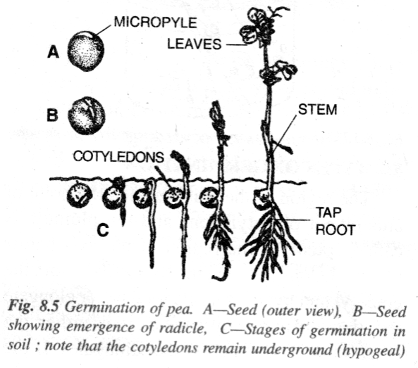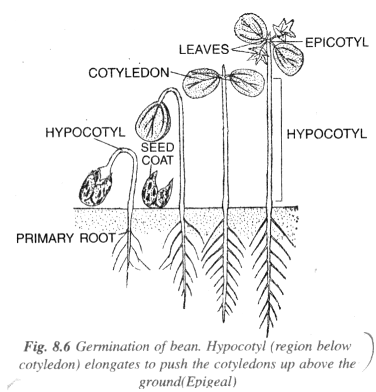What is Germination
The seed contains a dormant embryo, which remains inactive in its dry state. This period of inactivity is known as dormancy, a time of rest. While the seed may appear lifeless, various slow chemical processes continue within it, consuming minimal food. Dry seeds still take in oxygen and release carbon dioxide in tiny amounts, also producing a small amount of heat. When exposed to the right conditions, the dormant embryo becomes active and starts to grow into a seedling. This process, known as germination, encompasses all the changes that transform the embryo into a seedling.
Fresh seeds from a plant typically do not germinate immediately, even under ideal conditions. They must first undergo a dormancy period, during which they achieve physiological maturation.
Condition Necessary for Germination
Water, an appropriate temperature, and oxygen are essential for seed germination.
Water: Seeds absorb water from their surroundings, typically from the soil under natural conditions. While water can be absorbed across the entire surface of the seed, the primary entry point is through the micropyle.
Suitable Temperature: Germination does not occur at very low or very high temperatures. Extremely low temperatures inhibit the embryo's growth, while excessively high temperatures can damage its delicate tissues. A moderately warm temperature is ideal for germination, often referred to as the optimum temperature.
Oxygen: Germination involves rapid cell division and growth, which require energy. This energy is generated through respiration (oxidation of food), necessitating the presence of oxygen (or air).
Types of Germination
The part of the stem between the cotyledons and the plumule is known as the epicotyl. The part of the stem below the cotyledons is referred to as the hypocotyl. During germination, the epicotyl and hypocotyl do not elongate simultaneously. Instead, either the epicotyl or the hypocotyl will elongate. When the epicotyl elongates, the cotyledons remain below the surface (or on the surface if the seed is on the ground), which is termed hypogeal germination, as seen in peas and grams. Conversely, when the hypocotyl elongates, the cotyledons are lifted above the ground, resulting in epigeal germination, as observed in castor beans and other similar plants.
| Hypogeal germination | Epigeal germination |
|---|---|
| 1. Cotyledons remain underground. 2. Epicotyl elongates. |
Cotyledons pushed above ground Hypocotyl elongates. |
A method to observe stages of germination. Fill sterilized sand in a glass vessel in which filter paper or ordinary white paper is lined beside the inner wall, and place seeds in between the paper and the glass. When water is added to the sand in the vessel, seeds will absorb the water and germinate in a few days.
Germination in some common Seeds
Pea Seed (Hypogeal Germination): As the seed absorbs water, it swells significantly, causing the outer covering, or testa, to soften and break open. The radicle then emerges, growing downward to form the root system, while the plumule grows upward to develop into the shoot of the seedling. Initially, the plumule is curved to protect the young shoot from damage as it emerges from the soil. The cotyledons provide nourishment to the seedling until it can sustain itself, after which they wither and shrink. Since the cotyledons stay below the soil during this process, the germination is termed hypogeal (hypo: below + geo: earth).

Bean Seed (Epigeal): The seed takes in water and expands. The radicle extends downward to form the root system. The hypocotyl arches, then straightens, lifting the cotyledons above the soil, indicating epigeal germination (epi: above; geo: earth). These cotyledons transform into the first green leaves but soon fall off as the true foliage leaves develop.

Maize Grain (Hypogeal): As the grain absorbs water, it swells significantly. The radicle pushes through the coleorhiza and the fruit wall, extending downward to establish the root system, although it eventually withers. New roots then emerge from the stem's base, known as adventitious roots.
.png)
The plumule breaks through its protective covering, the coleoptile, and grows vertically. The two protective sheaths, the coleorhiza and coleoptile, are visible as membranous layers on the seedling's axis.
The cotyledon, known as the scutellum, absorbs nutrients from the endosperm until it is depleted. The hypocotyl does not extend during this process. This type of germination is known as hypogeal germination.
In mangrove species like Rhizophora and Sonneratia, a unique type of germination called vivipary occurs. In vivipary, seeds begin to germinate while still attached to the parent plant and encased in the fruit. Once germination occurs, the seedling drops to the ground, where it takes root and establishes itself. Vivipary refers to the process of producing live young.
The Seedling
The germination process concludes with the formation of a seedling.
A seedling represents the early stage of a plant's development from a seed before it becomes entirely self-sufficient in terms of food production.
During this stage, the seedling's roots absorb water and minerals from the soil, while its leaves begin the process of photosynthesis to produce food. The young plant continues to grow, eventually maturing and producing flowers and seeds.